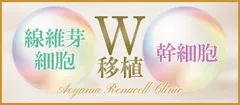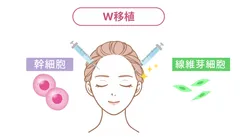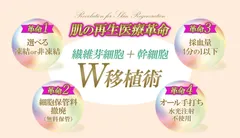Aoyama Renacell Clinic Revamps "Skin Regenerative Medicine Industry Developed the first simultaneous transplantation therapy of dermal fibroblasts and stem cells
Total regeneration of deep lines, dark circles, and acne scars through the synergistic effect of two cells
一般社団法人輝実会 青山レナセルクリニック
Aoyama Renacell Clinic (Aoyama NA Building 3F, 2-7-28 Kita-Aoyama, Minato-ku, Tokyo) has established advanced cell culture technology in the in-house CPC and submitted a new Type 2 Regenerative Medicine Provision Plan "Autologous cultured dermal fibroblast transplantation" to the Ministry of Health, Labor and Welfare, which was accepted (Plan number: PB 3250067).
Dermal fibroblasts, which make up the dermis layer, the lower layer of the epidermis of human skin, produce collagen, elastin, and hyaluronic acid, the three major components of skin, and also have the very important function of promoting the metabolism of collagen fibers. As a result, skin deterioration such as wrinkles and sagging occurs.
For this reason, a treatment called "dermal fibroblast transplantation," which utilizes a mechanism whereby a piece of skin is extracted from behind the patient's ear, fibroblasts are extracted and grown, and transplanted into the face and neck to restore collagen and other production capacity, thereby reviving lost skin firmness and elasticity, has been popular in Japan for about 20 years.
As a comprehensive regenerative medicine clinic focusing on stem cell therapy, we have notified a total of 10 Type 2 Regenerative Medicine Provision Plans for diverse diseases such as diabetes, osteoarthritis, and ED, and provide both stem cell-based therapy and the aforementioned dermal fibroblast transplant therapy as skin regenerative medicine.
In the process of accumulating clinical results of transplantation therapy of both stem cells and fibroblasts over the past four years, we have come into contact with research reports showing that these two cell types have a high affinity, that fibroblasts have a significantly enhanced collagen-producing capacity when coexisting with stem cells, and that stem cells themselves produce collagen and form collagen fibers at least as much as fibroblasts. Stem cells are also known to produce collagen and form collagen fibers more effectively than fibroblasts.
Unlike fibroblasts, stem cells have the unique ability to differentiate into a variety of cells, including adipocytes and epidermal cells in the subcutaneous tissue ("differentiation potential"), and they secrete hundreds of growth factors such as VEGF (vascular endothelial growth factor) in abundance. This allows us to expect complex effects such as improved blood flow and suppression of inflammation, which are not possible with fibroblasts.
For this reason, our clinic has recently developed the "W Transplantation Therapy" based on the judgment that maximum synergistic effects can be expected from the simultaneous transplantation of these two types of cells into the skin.
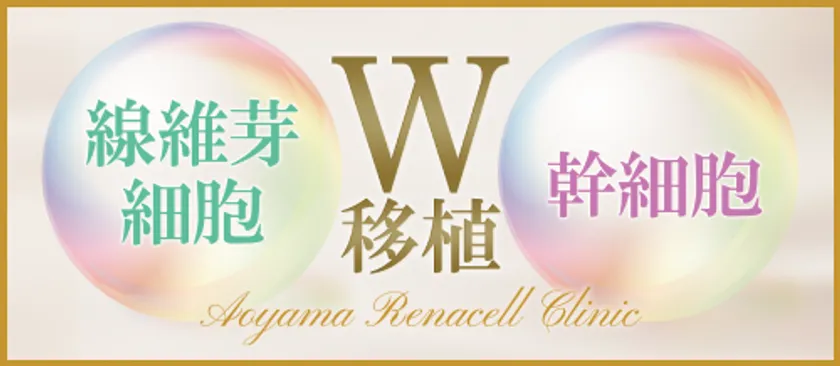
Illustration (1)
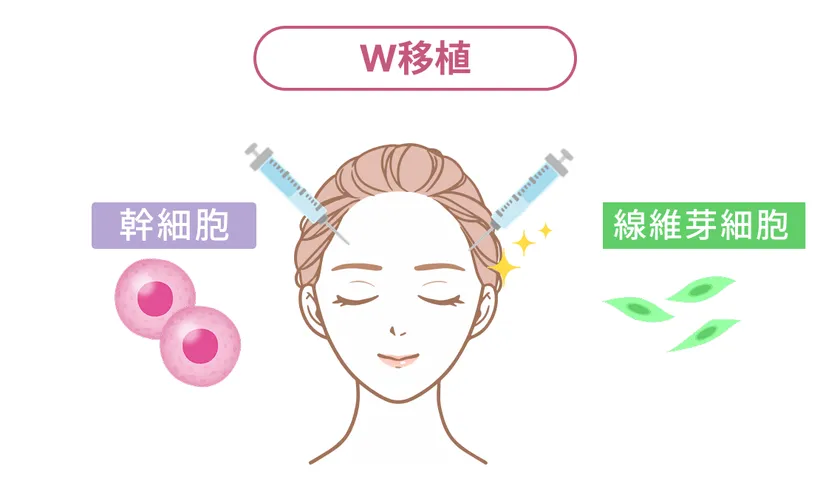
Illustration (2)
This treatment is positioned as the optimal approach for middle-aged and older patients, especially those with deep lines due to atrophy and reduction of fat in the subcutaneous tissue with aging, as well as dark circles under the eyes due to weakening of the dermal layer and deterioration of blood flow, in addition to loss of firmness and elasticity due to a decrease in dermal fibroblasts.
We also recommend the "Value Plan" treatment menu for middle-aged and older patients, which combines stem cell infusion therapy with local injections into the skin and scalp to provide total body anti-aging care, and it has been well received.
The current fibroblast therapy industry in Japan has a number of irrational problems, such as high cell storage fees of 100,000-200,000 yen per year and the inability to accommodate patients' changing treatment schedules because the cells are not provided in a frozen state after culturing.
For this reason, we are now proposing a new treatment method and at the same time, we will improve all of these structural problems unique to the industry and make the following changes.
1) Elimination of cell storage fees (free of charge)
2) The ability to flexibly select the form of cell donation (frozen or unfrozen) at the time of transplantation.
3) Significant reduction in the amount of blood collection required for culture (about 25% of the conventional amount)
4) No use of introduction devices such as water light injections, which have a high cell loss rate.
The above innovations will significantly improve the convenience and cost-effectiveness of treatment for patients who wish to undergo skin regenerative medicine.

Illustration (3)
Company Profile
Company name: General Incorporated Association Kisumikai Aoyama Renacell Clinic
Representative Director: Taro Tsuchiya
Location : 3F Aoyama NA Building, 2-7-28 Kita-Aoyama, Minato-ku, Tokyo
Establishment : May 21, 2020
Business: Operation of regenerative medicine clinics
URL : https://rena-cell.com
- Category:
- Technology & Development
- Genres:
- Beauty Medical care Other Lifestyles
